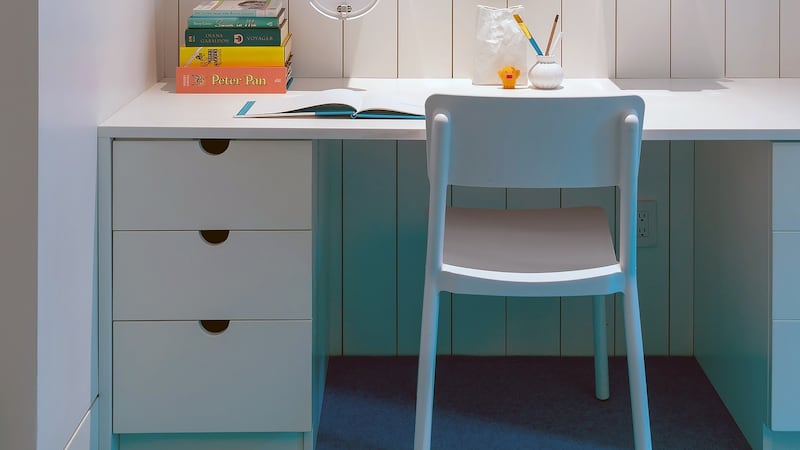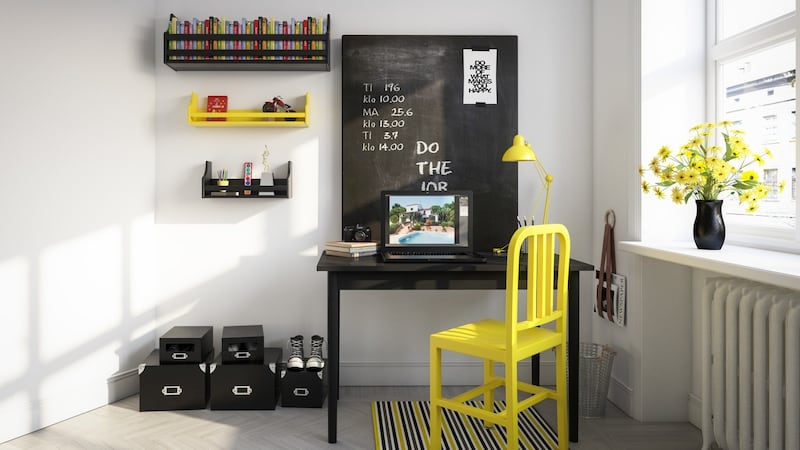Like many people's homes at the moment, mine now resembles a juvenile corporate office. My six-year-old logs into Zoom for morning meetings and singalongs, my eight-year-old uses Google Docs to pitch fairy-tale adaptations to his teacher, and both use new email accounts to compare schedules with classmates and dole out emojis.
When schools closed, my wife and I scrambled to gather the digital gear and download the multitude of apps that enable online learning. But like so many parents suddenly required to work from home, we devoted an equal amount of time to fretting about how we could all complete our tasks in such close quarters, without ending up in a daily battle royale.
Fortunately, our eight-year-old’s teacher, Jennifer Frish, had some ideas for keeping the peace. The day before online classes began, she encouraged parents to set up a dedicated learning space for their children. For strategies on how to do that successfully, I asked educators and interior designers for advice.
Give them their own space
Pulling a stool up to the kitchen island, which might have worked for casual homework, isn’t going to cut it when your child will be studying all day, every day, for weeks or months. Adding a small desk, if you have the space, is one easy option for creating a dedicated space.
But it is not the only solution. One end of a dining table can work just as well, Frish says, as long as the space is clearly demarcated and reserved for the child’s use. “You could block it off with masking tape,” she says. “Or get a cardboard divider.” In the classroom, Frish has privacy partitions from Lakeshore Learning Materials available for students who need help focusing, but you could just as easily make one from a cardboard box, she says. Especially now that you’re having so many purchases delivered.
If your child already has a desk, it is probably covered with everything but tools for learning, says interior designer Ghislaine Vinas, in which case it needs a refresh. “If your kid is lucky enough to have a desk in the apartment, take everything off that desk, give it a good clean and start over,” Vinas says.
Design with your children
Your child’s desk is not the place to showcase your personal design ambitions. More than anything else, Frish stressed the importance of including your child in the design process.
“It’s extremely important not only to set up a space, but to have them plan it out with you,” she says. “It gives them ownership and, later on, more accountability.” The goal, she added, is to end up with a workspace where they will love spending time. One way Vinas has helped her children, who are now teenagers, create personalised workspaces over the years is by encouraging them to make collages.

"Take images from Instagram or whatever else inspires them. Print them, cut them out and create beautiful collages of things that are meaningful to them," she says. "They can look at those things, dream and stay inspired."
Provide tools for organisation
Having storage space for school supplies is critical to supporting learning and maintaining sanity.
“Sharpen all the pencils, have extra paper and make sure you have a place where everything goes back to,” says Julie Bogart, author of The Brave Learner: Finding Everyday Magic in Homeschool, Learning, and Life and founder of online learning company Brave Writer, who home-schooled her five children.
In her house, the children would return all their learning materials to individual cubbies at the end of each day, she says, so they were always ready to go the next morning. “One of the big jokes in the home-schooling market is, ‘I don’t know where the maths book is,’” she noted, “because so often kids lose it somewhere, or hide it.”
Baskets, bins and cups can help keep various types of materials separated while containing the clutter. They don’t have to be fancy. Shoeboxes and plastic containers can be repurposed as holders of notebooks and markers, and Vinas recommended painting soup cans to make pencil cups.
To keep those containers organised – and off the floor and desktop – consider adding shelves near the desk, says Joan Enger, founder of J Patryce Design & Company.
For one teen's study, Enger installed a bookcase for storing baskets of different sizes, along with books and magazine files. And for her son, she added a wall-mounted shelf directly above his desk. "He has dual monitors and all this computer stuff on his desk," she says. "So we just put an Ikea shelf right above the desk," to catch everything else.
Offer various options for seating
At school, children often have a wide variety of seating options. When it’s reading time in Frish’s class, some students sit at group tables, some use benches, some opt for sitting on the rug with a pillow and one lucky child might snag the beanbag chair.

“The biggest thing is that we want kids to feel comfortable in their workspace,” she says. Trying to get a child to sit on a hard desk chair for six to eight hours a day is a fool’s errand, so offer at least a couple of choices – a desk chair, for example, along with floor pillows.
If you have the space, you could set up multiple workstations for different tasks, says Michelle Gerson, an interior designer.
Add headphones and a task lamp
In the same way that you probably don’t appreciate a kindergartner’s singalong while taking an important business call, children likely don’t want to hear your Zoom presentation while trying to tackle long division. Headphones can help, Frish says, by shutting out background noise.
A task lamp is also important, Enger says. “Overhead lighting is not really conducive to studying, especially if you’re doing writing or reading,” she says. “A task lamp offers more direct lighting.” She recommended looking for a simple, inexpensive LED-based model that takes up a minimum of desk space.
Be flexible
Try to remember that no matter how much you work on the design of a child’s study space, it is no classroom. “School is designed as an institution with desks, classrooms, blackboards and teachers in the front of the room to create an environment that helps children cooperate with the agenda,” Bogart says. “Home is not like that. Home is where we come to get relief from that, where we don’t have to perform and where we relax.”
Trying to create a strict, school-like environment at home “is like oil and water – and your kids know it”, she says. “They don’t cooperate the way they do for the teacher.” So when things start going off the rails, the best response may be to take a deep breath and embrace the idea that learning can happen just about anywhere.
“Some children are much more likely to do their handwriting practice if you give it to them on a clipboard, set them up in the corner of the sectional, tuck them in with a blanket and let them pet the cat,” Bogart says. “In other words, we’re borrowing from the divine wonder of home,” she adds. “It’s about balancing the yin and the yang.” – New York Times service














